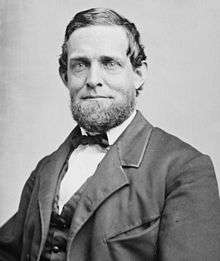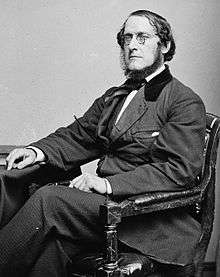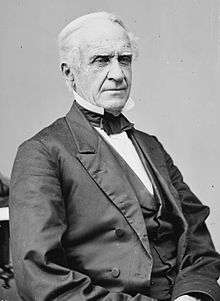United States House of Representatives elections, 1864 and 1865
|
| |||||||||||||||||||||||||||||||||||||||||||||||
| |||||||||||||||||||||||||||||||||||||||||||||||
All 193[Note 2] seats to the United States House of Representatives 97 seats were needed for a majority | |||||||||||||||||||||||||||||||||||||||||||||||
|---|---|---|---|---|---|---|---|---|---|---|---|---|---|---|---|---|---|---|---|---|---|---|---|---|---|---|---|---|---|---|---|---|---|---|---|---|---|---|---|---|---|---|---|---|---|---|---|
| |||||||||||||||||||||||||||||||||||||||||||||||
| |||||||||||||||||||||||||||||||||||||||||||||||
Elections to the United States House of Representatives were held in 1864 to elect Representatives to the 39th United States Congress. The election coincided with the presidential election of 1864, in which President Abraham Lincoln was re-elected.
In the midst of the American Civil War, the opposition Democrats were divided between the Copperheads, a group that demanded an immediate negotiated settlement with the Confederate States of America, and the War Democrats, who supported the war. The Democrats lacked a coherent message, and Lincoln's Republican Party gained 50 seats, increasing their majority over the Democrats. The National Union Party (formerly known as the Unionists) lost seven seats, retaining control of 18 seats (some classify the Representatives as including 13 Unconditional Unionists and five Unionists), all from the border states of Maryland, Tennessee, and Kentucky, as well as West Virginia.
Election summaries
One new seat was added for the new State of Nevada[1] and 8 vacancies were filled by the readmission of Tennessee, the first secessionist state to be readmitted. Three former Confederate States held elections in 1865 that were rejected by Congress.
| 137 | 18 | 38 |
| Republican | Unionist | Democratic |
| State | Type | Date | Total seats |
Republican | Democratic | Unionist[Note 4] | |||
|---|---|---|---|---|---|---|---|---|---|
| Seats | Change | Seats | Change | Seats | Change | ||||
| Oregon | At-large | June 5, 1864 | 1 | 1 | 0 | 0 | |||
| Vermont | District | September 6, 1864 | 3 | 3 | 0 | 0 | |||
| Maine | District | September 11, 1864 | 5 | 5 | 0 | 0 | |||
| Indiana | District | October 10, 1864 | 11 | 9 | 2 | 0 | |||
| Nevada[Note 5] | At-large | 1 | 1 | 0 | 0 | ||||
| Ohio | District | 19 | 17 | 2 | 0 | ||||
| Pennsylvania | District | 24 | 16 | 8 | 0 | ||||
| West Virginia | District | October 22, 1864 | 3 | 0 | 0 | 3 | |||
| California | District[Note 6] | November 8, 1864 (Election Day)[Note 7] |
3 | 3 | 0 | 0 | |||
| Delaware | At-large | 1 | 0 | 1 | 0 | ||||
| Illinois | District + 1 at-large |
14 | 11 | 3 | 0 | ||||
| Iowa | District | 6 | 6 | 0 | 0 | ||||
| Kansas | At-large | 1 | 1 | 0 | 0 | ||||
| Maryland | District | 5 | 0 | 2 | 3 | ||||
| Massachusetts | District | 10 | 10 | 0 | 0 | ||||
| Michigan | District | 6 | 6 | 0 | 0 | ||||
| Minnesota | District | 2 | 2 | 0 | 0 | ||||
| Missouri | District | 9 | 8[Note 3] | 1 | 0 | ||||
| New Jersey | District | 5 | 2 | 3 | 0 | ||||
| New York | District | 31 | 21 | 10 | 0 | ||||
| Wisconsin | District | 6 | 5 | 1 | 0 | ||||
| 1865 elections | |||||||||
| New Hampshire | District | March 14, 1865 | 3 | 3 | 0 | 0 | |||
| Connecticut | District | April 3, 1865 | 4 | 4 | 0 | 0 | |||
| Rhode Island | District | April 5, 1865 | 2 | 2 | 0 | 0 | |||
| Tennessee[Note 8] | District | August 3, 1865[Note 9] | 8 | 0 | 0 | 8 | |||
| Kentucky | District | August 7, 1865 | 9 | 0 | 5 | 4 | |||
| Nevada | At-large | November 7, 1865 | 1 | 1 | 0 | 0 | |||
| Secessionist States not yet readmitted | |||||||||
| Alabama | District | 6 | |||||||
| Arkansas | District | 3 | |||||||
| Florida | At-large | November 29, 1865[Note 10] | 1 | ||||||
| Georgia | District | 7 | |||||||
| Louisiana | District | 5 | |||||||
| Mississippi | District | October 2, 1865[Note 10] | 5 | ||||||
| North Carolina | District | November 9, 1865[Note 10] | 7 | ||||||
| South Carolina | District | 4 | |||||||
| Texas | District | 4 | |||||||
| Virginia | District | 8 | |||||||
| Total[Note 2] | 193 50 vacancies[Note 11] |
137[Note 3] 71.0% |
38 19.7% |
18 9.3% |
|||||
Of the rejected elections, Florida's and Mississippi's claimants' parties are unknown, while North Carolina elected 4 Union and 3 Conservative Representatives.
California
Note: This was the first election in which California elected representatives from congressional districts.
| District | Incumbent | Party | First elected |
Result | Candidates |
|---|---|---|---|---|---|
| California 1 New seat |
Cornelius Cole Redistricted from the at-large district. |
Republican | 1863 | Unknown if incumbent retired or lost renomination. New member elected. |
√ Donald C. McRuer (Republican) 58.2% Joseph B. Crockett (Democratic) 41.8% |
| California 2 New seat |
William Higby Redistricted from the at-large district. |
Republican | 1863 | Incumbent re-elected. | √ William Higby (Republican) 61.3% James W. Coffroth (Democratic) 38.7% |
| California 3 New seat |
Thomas B. Shannon Redistricted from the at-large district. |
Republican | 1863 | Incumbent retired. New member elected. Republican hold. |
√ John Bidwell (Republican) 55.8% Jackson Temple (Democratic) 44.2% |
Nevada
On October 31, 1864, the new state of Nevada elected Republican Henry G. Worthington to finish the term ending March 3, 1865.
| District | Incumbent | Party | First elected |
Result | Candidates |
|---|---|---|---|---|---|
| Nevada at-large | New state | New member elected October 31, 1864. Republican gain. |
√ Henry G. Worthington (Republican) 9,776 votes Other 6,552 votes[2] | ||
Worthington was not renominated for the next term, however, and on November 7, 1865, Republican Delos R. Ashley was elected for the term that had already begun but would not formally meet until December 4, 1865.
| District | Incumbent | Party | First elected |
Result | Candidates |
|---|---|---|---|---|---|
| Nevada at-large | Henry G. Worthington | Republican | 1864 (New state) | Incumbent lost renomination.[2] New member elected November 7, 1865. Republican hold. |
√ Delos R. Ashley (Republican) 3,691 votes Henry K. Mitchell 2,215 votes[3] |
Ohio
| District | Incumbent | Party | First elected |
Result | Candidates[4] |
|---|---|---|---|---|---|
| Ohio 1 | George H. Pendleton | Democratic | 1856 | Incumbent retired to run for U.S. Vice President. New member elected. Republican gain. |
|
| Ohio 2 | Alexander Long | Democratic | 1862 | Incumbent lost renomination. New member elected. Republican gain. |
|
| Ohio 3 | Robert C. Schenck | Republican | 1862 | Incumbent re-elected. |
|
| Ohio 4 | John F. McKinney | Democratic | 1862 | Incumbent lost re-election. New member elected. Republican gain. |
|
| Ohio 5 | Francis C. Le Blond | Democratic | 1862 | Incumbent re-elected. |
|
| Ohio 6 | Chilton A. White | Democratic | 1860 | Incumbent lost re-election. New member elected. Republican gain. |
|
| Ohio 7 | Samuel S. Cox | Democratic | 1862 | Incumbent lost re-election. New member elected. Republican gain. |
|
| Ohio 8 | William Johnston | Democratic | 1862 | Incumbent lost re-election. New member elected. Republican gain. |
|
| Ohio 9 | Warren P. Noble | Democratic | 1860 | Incumbent lost re-election. New member elected. Republican gain. |
|
| Ohio 10 | James M. Ashley | Republican | 1862 | Incumbent re-elected. |
|
| Ohio 11 | Wells A. Hutchins | Democratic | 1862 | Incumbent lost re-election. New member elected. Republican gain. |
|
| Ohio 12 | William E. Finck | Democratic | 1862 | Incumbent re-elected. |
|
| Ohio 13 | John O'Neill | Democratic | 1862 | Incumbent retired. New member elected. Republican gain. |
|
| Ohio 14 | George Bliss | Democratic | 1862 | Incumbent lost re-election. New member elected. Republican gain. |
|
| Ohio 15 | James R. Morris | Democratic | 1862 | Incumbent lost re-election. New member elected. Republican gain. |
|
| Ohio 16 | Joseph W. White | Democratic | 1882 | Incumbent lost re-election. New member elected. Republican gain. |
|
| Ohio 17 | Ephraim R. Eckley | Republican | 1862 | Incumbent re-elected. |
|
| Ohio 18 | Rufus P. Spalding | Republican | 1862 | Incumbent re-elected. |
|
| Ohio 19 | James A. Garfield | Republican | 1862 | Incumbent re-elected. |
|
See also
Notes
- ↑ Excludes states admitted after the start of Congress.
- 1 2 Including late elections.
- 1 2 3 Includes 1 Independent Republican, John R. Kelso, elected to MO-04.
- ↑ Including Unconditional Unionists.
- ↑ New state.
- ↑ Changed from at-large.
- ↑ Although "An Act to establish a uniform time for holding elections for electors of President and Vice President in all the States of the Union (28th Congress, 2nd Session, Chapter 1, 5 Stat. 721, enacted January 23, 1845) was only for presidential elections, the date was gradually adopted by the states for Congressional elections.
- ↑ Readmitted state.
- ↑ Not admitted until July 24, 1866.
- 1 2 3 Rejected election.
- ↑ There were a total of 50 vacancies remaining, after the readmission of Tennessee.
References
- ↑ 14 Stat. 391
- 1 2 History of Nevada, p. 87.
- ↑ History of Nevada, p. 88–89.
- ↑ Smith, Joseph P, ed. (1898). History of the Republican Party in Ohio. I. Chicago: the Lewis Publishing Company. pp. 195, 196.
Bibliography
- Dubin, Michael J. (March 1, 1998). United States Congressional Elections, 1788-1997: The Official Results of the Elections of the 1st Through 105th Congresses. McFarland and Company. ISBN 978-0786402830.
- Martis, Kenneth C. (January 1, 1989). The Historical Atlas of Political Parties in the United States Congress, 1789-1989. Macmillan Publishing Company. ISBN 978-0029201701.
- Moore, John L., ed. (1994). Congressional Quarterly's Guide to U.S. Elections (Third ed.). Congressional Quarterly Inc. ISBN 978-0871879967.
- Thompson; West (1881). History of Nevada. Oakland, California. Retrieved May 29, 2018.
- "Party Divisions of the House of Representatives* 1789–Present". Office of the Historian, House of United States House of Representatives. Retrieved January 21, 2015.
External links
- Office of the Historian (Office of Art & Archives, Office of the Clerk, U.S. House of Representatives)
- "Elections 1860 - 1869". JoinCalifornia / Election History for the State of California. Retrieved February 12, 2018.


